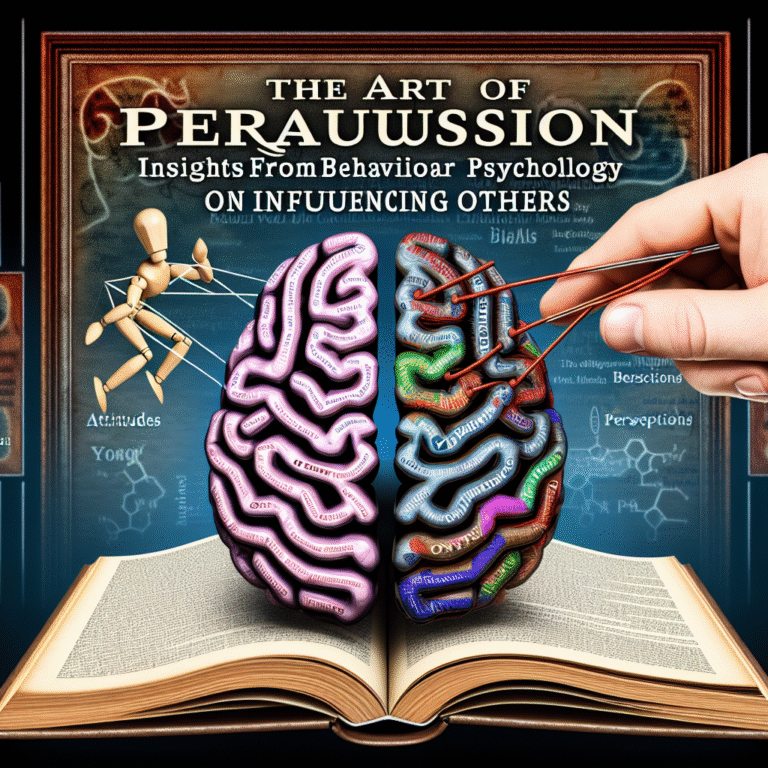
Behavioral Insights: The Ultimate Frontier in Understanding What Consumers Really Want
Introduction: The Quest for Understanding
In today’s hyper-connected world, consumers are inundated with choices—from the clothes they wear to the brands they trust. Yet, beneath the surface of these decisions lies a labyrinth of motivations, fears, and desires that drive purchasing behavior. Enter Behavioral Insights: The New Frontier in Understanding What Consumers Really Want. This fascinating field merges psychology and data-driven marketing, offering a powerful lens through which companies can decipher the complexities of consumer behavior.
Today, every choice a consumer makes is influenced by a multitude of factors. This makes understanding why they make these choices more vital than ever. As businesses strive to meet consumer needs in real-time, uncovering the underlying principles of behavioral insights not only positions them ahead of the curve but also helps build lasting relationships with their audiences.
The Foundation of Behavioral Insights
What Are Behavioral Insights?
Behavioral insights delve into the nuances of human behavior, focusing on factors that influence decision-making. By applying principles derived from psychology, economics, and behavioral science, organizations can better predict how consumers will react to products, marketing strategies, and even pricing models.
Why Are They Essential?
Understanding behavioral insights is crucial for several reasons:
Consumer Autonomy: Today’s consumers are more informed and empowered than ever. Grasping their motivations allows businesses to craft personalized experiences that resonate deeply.
Data-Driven Decisions: With the vast amount of data available, companies can analyze trends and patterns to inform their strategies. Using behavioral insights ensures these strategies are grounded in real human behavior rather than assumptions.
- Competitive Advantage: Brands that effectively utilize behavioral insights often outperform their competitors by fostering better engagement and loyalty.
The Role of Behavioral Economics
At the heart of behavioral insights is behavioral economics, which challenges the traditional economic theory that assumes consumers act rationally. It posits that emotions and cognitive biases significantly influence consumers, leading to decisions that may not align with their best interests.
Key Principles of Behavioral Insights
Loss Aversion: Consumers prefer avoiding losses over acquiring equivalent gains. This principle can shape how marketing messages are crafted.
Framing Effects: The way information is presented can drastically alter its response. A 20% discount sounds better than a “Save $5” tagline, even if they result in the same outcome.
- Social Proof: People often look to others when making decisions. Incorporating user reviews and testimonials into marketing strategies amplifies trust in a brand.
Real-World Applications of Behavioral Insights
Case Study 1: Starbucks and the Power of Habit
Background: Starbucks has harnessed behavioral insights to create a customer experience that transforms occasional visitors into loyal patrons.
Strategy: By using the ‘habit loop’ framework—cue, routine, reward—Starbucks cultivated an environment where purchasing coffee became a daily ritual.
Outcome: This behavioral approach led to greater customer loyalty, with consumers associating their daily caffeine fix with feelings of comfort and community.
Relevance: Starbucks’s application reinforces the idea that consumers often lean towards habitual behaviors that provide emotional satisfaction. Understanding these habits allows businesses to tailor experiences that resonate with their customers.
Case Study 2: The IKEA Effect
Background: Research reveals that consumers value products they have a hand in creating, dubbed the IKEA effect.
Strategy: IKEA’s business model encourages customers to assemble their own furniture, transforming their role from mere consumers to active participants.
Outcome: This strategy not only enhances perceived value but also cultivates a sense of ownership and pride in the product.
Relevance: By integrating behavioral insights, IKEA tapped into intrinsic motivations, demonstrating how consumer participation can lead to increased satisfaction and loyalty.
Case Study 3: Amazon’s Personalization Tactics
Background: Amazon is a prime example of employing behavioral insights at scale. The brand leverages data to deliver personalized shopping experiences.
Strategy: Through algorithms that analyze past purchases, search history, and even wish lists, Amazon tailors recommendations that resonate with individual consumers.
Outcome: Personalization has proven to significantly boost sales, as customers are more likely to purchase items that align with their preferences.
Relevance: This case illustrates the intersection of data and behavioral insights, showcasing how a tailored approach can drive consumer engagement and increase conversion rates.
Leveraging Behavioral Insights in Marketing
Creating Effective Marketing Strategies
When integrating behavioral insights into marketing strategies, consider the following dimensions:
Emotional Appeals: Utilize storytelling to connect on a human level, tapping into emotions that resonate with your target audience.
Scarcity and Urgency: Limited-time offers create a sense of urgency, prompting consumers to act quickly to avoid missing out.
- Gamification: Introducing gamified elements can stimulate engagement, making the experience enjoyable and enhancing customer loyalty.
Measuring Impact
Key Performance Indicators (KPIs)
Engagement Rates: Track how different strategies perform over time.
Customer Retention: Monitor how often repeat purchases occur, indicating customer loyalty.
- Conversion Rates: Assess the effectiveness of marketing strategies in driving purchases.
Adapting Based on Data
Behavioral insights aren’t static; they evolve alongside consumer behavior. Therefore, continuously revising strategies based on performance data is crucial for sustained success.
Engaging Consumers through Social Media
The Digital Landscape
Social media has transformed how brands interact with consumers. Behavioral insights can help identify how to engage effectively across these platforms.
Authenticity: Consumers are increasingly drawn to brands that are transparent and genuine. Sharing behind-the-scenes content humanizes the brand.
- User-Generated Content: Encouraging consumers to share their experiences cultivates community and reinforces the brand message.
Social Listening
Employing tools to monitor consumer sentiment can yield valuable insights into what resonates with your audience. This proactive approach ensures brands stay aligned with consumer preferences.
Conclusion: The Way Forward
As we navigate through the complexities of modern consumer behavior, Behavioral Insights: The New Frontier in Understanding What Consumers Really Want offers a roadmap for brands eager to connect more meaningfully with their audiences. By adopting these insights and marrying them with data-driven strategies, businesses can illuminate the path toward creating valuable customer experiences that foster loyalty and growth.
The journey doesn’t end here. Embracing behavioral insights is an ongoing process—one that invites innovation and adaptability. Whether you’re a startup or a seasoned enterprise, understanding the motivations behind consumer choices will enrich your marketing efforts and set you on a trajectory toward lasting success.
FAQs about Behavioral Insights
1. What are behavioral insights?
Behavioral insights refer to the understanding of human behavior, particularly how emotions, biases, and social influences affect decision-making.
2. How do behavioral insights differ from traditional marketing research?
While traditional marketing research often relies on surveys and demographic data, behavioral insights focus on the underlying psychological factors that drive consumer behavior.
3. Can small businesses utilize behavioral insights effectively?
Absolutely! Small businesses can leverage behavioral insights through targeted marketing strategies and by engaging with customers in personalized ways, often cost-effectively.
4. What role does technology play in behavioral insights?
Technology enables brands to gather and analyze consumer data, allowing for tailored marketing strategies based on real-time behavior.
5. How can I apply behavioral insights in my marketing?
Focus on understanding your audience’s emotions and motivations. Utilize techniques like personalization, emotional storytelling, and consumer engagement through social media.
By embracing the power of behavioral insights, businesses are not just adapting to change—they are anticipating it, ensuring they remain relevant in an ever-evolving marketplace.














